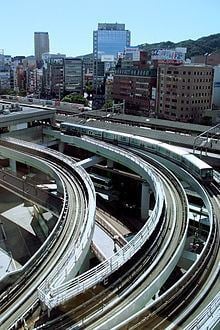Opened February 5, 1981 | Stations 12 Line length 10.8 km (6.71 mi) | |
 | ||
Terminis | ||
From sannomiya station portliner to nitori shop
The Port Island Line (ポートアイランド線, Pōtoairando-sen), commonly known as Port Liner (ポートライナー, Pōtorainā) is an urban automated guideway transit (AGT) system in Kobe, Japan, operated by Kobe New Transit. When opened in 1981, the Port Liner was the first urban transport AGT in the world (this title disputed also by Lille's VAL, which opened in 1983).
Contents
- From sannomiya station portliner to nitori shop
- Kobe port island line 2 2
- Route
- Stations
- Rolling stock
- References
The initial system linked Sannomiya Station, Kobe's main transit hub, to the man-made Port Island, covering a distance of 6.4 km with 9 stations. On February 2, 2006, the line was extended by 4.3 km to the new Kobe Airport, built on an artificial island near Port Island.
Kobe port island line 2 2
Route
As the map indicates, the present system consists of one straight line, originating at Sannomiya Station and terminating at Kobe Airport Station, and a loop attached to the middle of the straight line. The stations on the former are numbered with prefix "P" and on the latter (except those shared with the former) are with prefix "PL".
Originally, before the 2006 extension to the airport, the loop section was single track and operated only counter-clockwise trains. Presently the main section between Sannomiya and the airport is entirely double track, but the remaining of the loop has not been rebuilt so that the three stations with PL prefix still serve only one way.
Stations
All stations are located in Chūō-ku, Kobe.
Minatojima Station, Iryō Center Station and K Computer Mae Stations were renamed on July 1, 2011, from Shimin Byōin Mae Station, Sentan Iryō Center Mae Station and Port Island Minami Station respectively.
